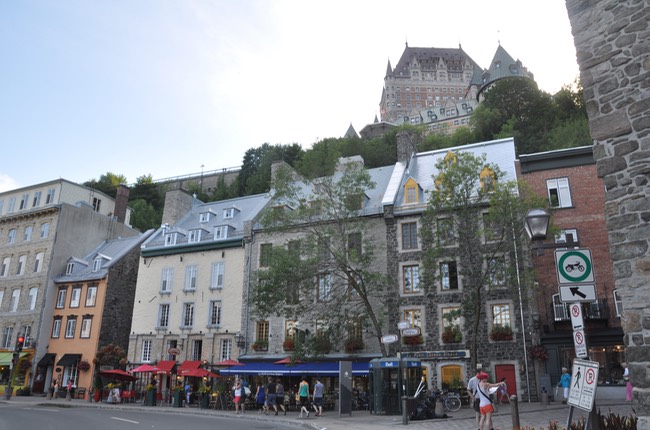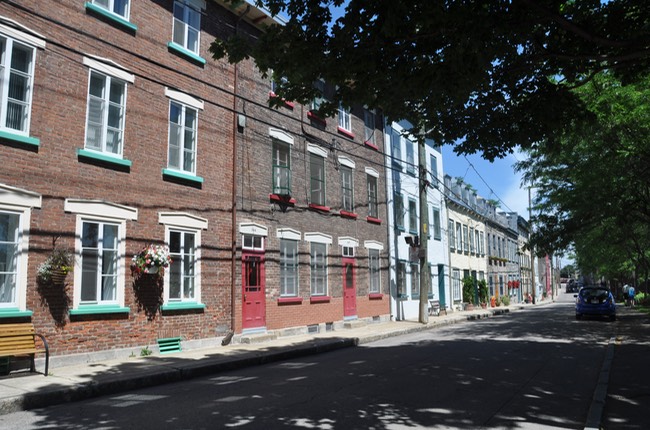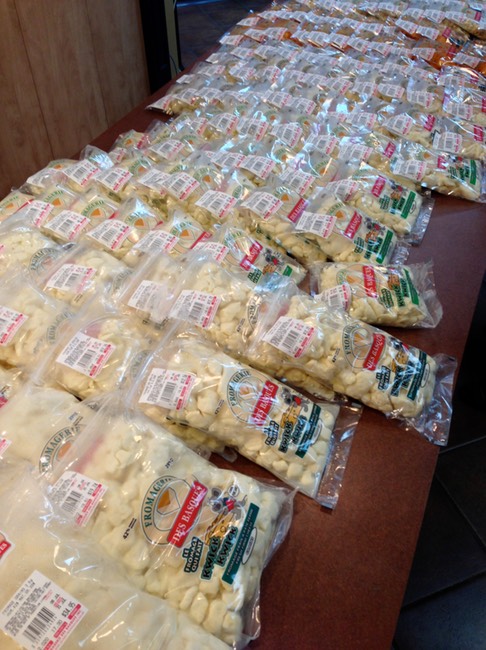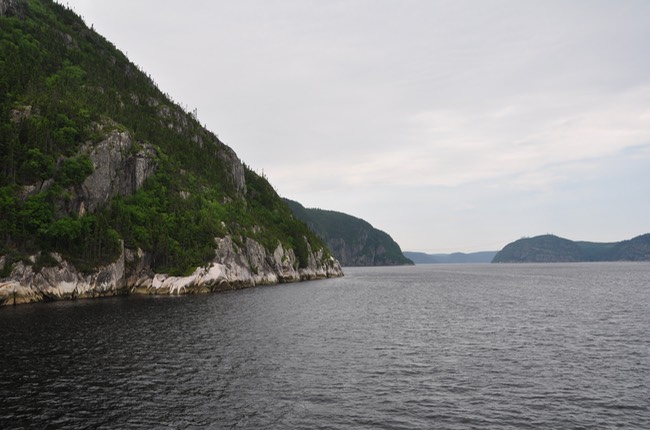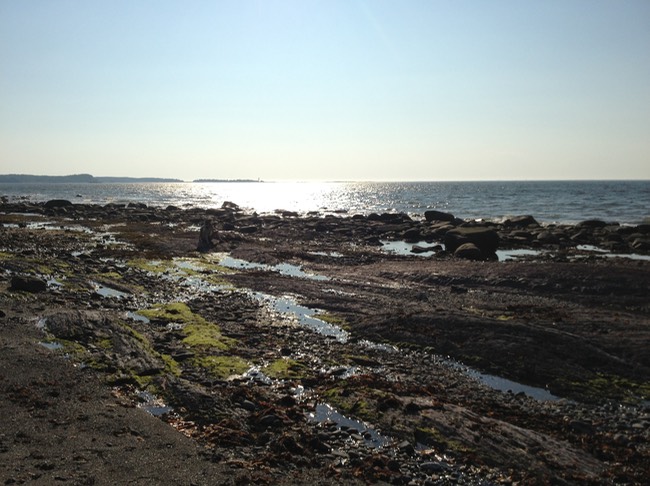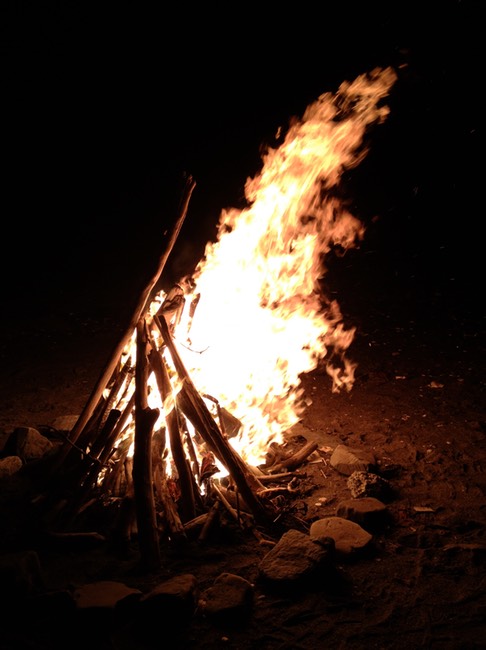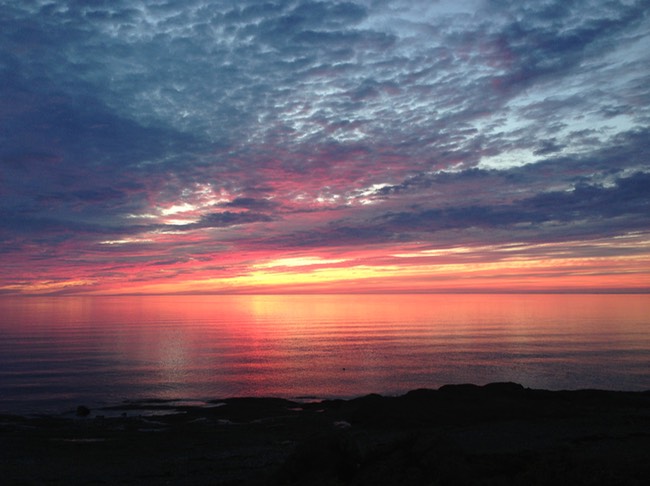Our Home and Native Land
En vacances in Quebec City
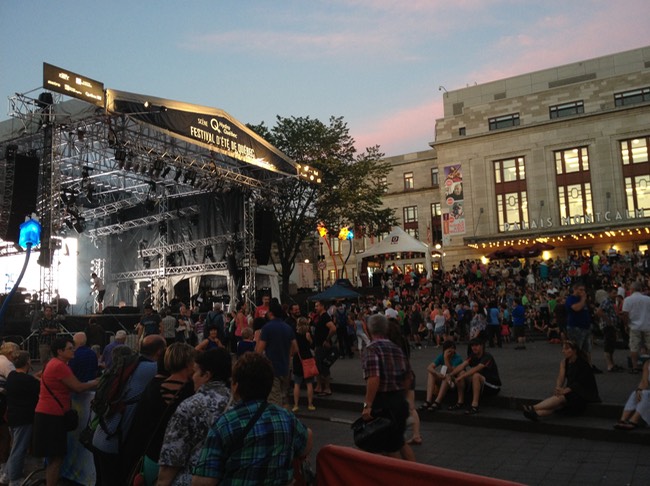
Quebec City, compact, charming, and francophone, is surely unique in North America. It is one of the oldest cities on the continent, and the only fortified city outside of Mexico. As a result, it is the most European experience to be had in Canada or the US. We spent five days there during the height of the Festival d’Eté, when the city was alive with music and street performers, and abuzz with visitors.
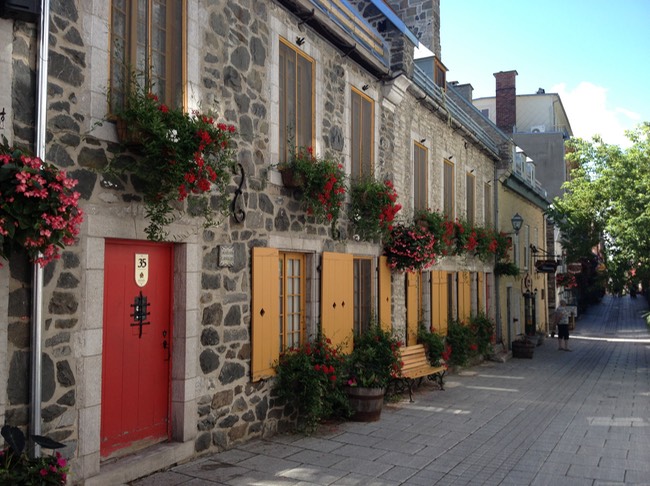
Spread out over a steep hill at the confluence of the Saint Laurence and Saint Charles rivers, its centre is fascinatingly complex. Vieux Quebec, where visitors spend most of their time, includes the ancient walls of what was once the upper city, and the lower city, a collection of winding streets between the walls and the river. Steep staircases, winding switchback roads, and a popular funicular move people between the two. The neighbourhood is dominated by cobblestones, charming unexpected squares, and narrow streets that wind their way up and down the steep hills. A highlight is rue Saint-Pierre, that winds through the lower town, affording views of gorgeous old stone buildings and providing a sense of age not often found in North America. Place Royale is another such corner, absolutely picturesque and charming.
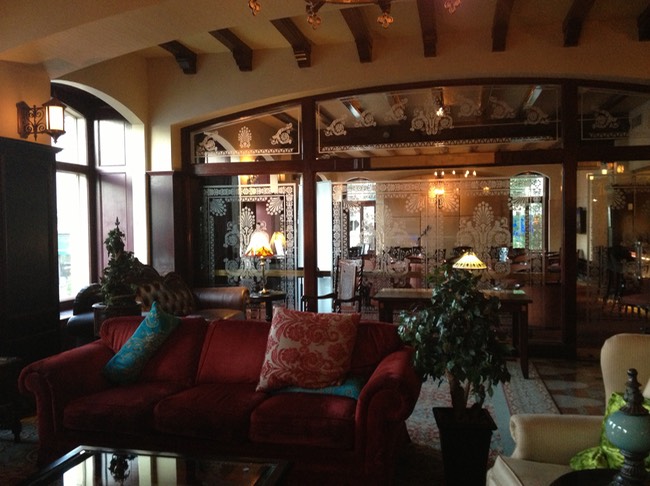
Delightfully, we stayed at the Hotel Clarendon, an historic building that claims to be the oldest purpose-built hotel in Canada. It boasts a serious art deco lobby ornamented with amazing stone and glasswork, and furnished in fat comfortable sofas, where we sat for awhile listening to vintage jazz while we waited for check-in time. Our room was on the top floor in the corner, with stunning views over Old Quebec. Chateau Frontenac rose up outside one of our windows, the harbour spread out beneath another. In the evening, the flood-lit chateau dominated our view, and we could watch the son et lumiere show being projected on the waterfront.
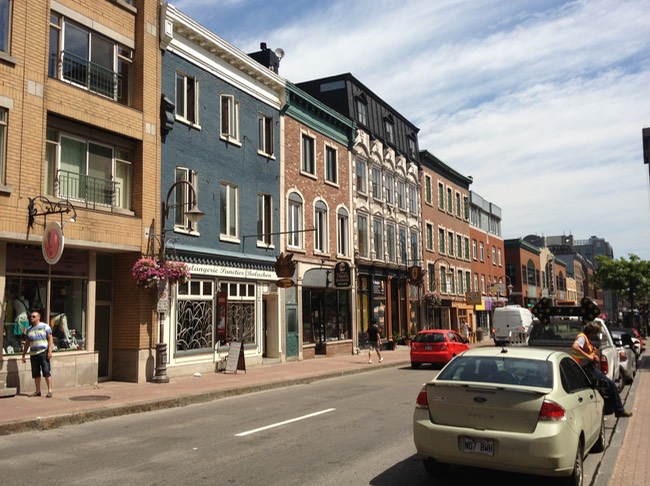
In our daily wanderings, we discovered a city of contrasts. Most tourist activity centres on the old city and the Plains of Abraham, a lovely park which was the site of one of Canada’s most famed battles. But there is also great charm to be found outside the walls. The popular Grand Allee is lined with sidewalk cafés and restaurants such as one finds in central Paris; it is very lively, but we preferred rue Saint-Joseph in the university district of Saint Roch. This street, home to excellent coffee, bakeries, and ethnic restaurants, was the heart of a working class nieghbourhood that was at one time covered with a roof and made into a shopping mall. It is now free and funky, fun for walking, shopping, and eating. We enjoyed both rue Cartier, with its contemporary shops and restaurants, and rue Saint-Jean, which winds its way out of the walled city and through the new town, lined with picturesque buildings housing charming shops and restaurants.
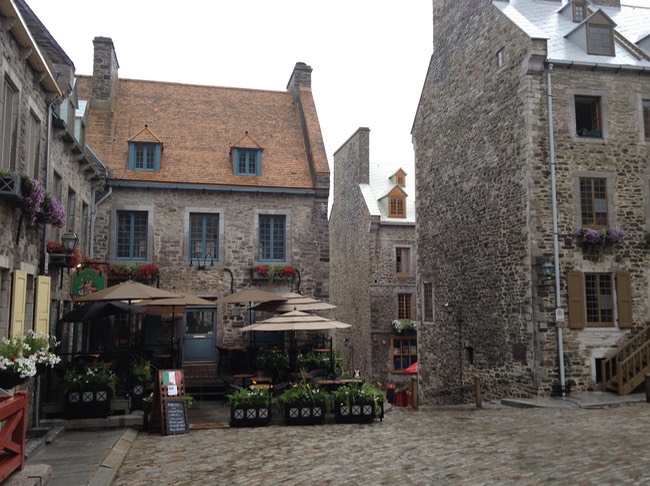
We had a variety of excellent food experiences during our stay. On our first night, we enjoyed ourselves at a touristy but pleasant creperie on rue Saint-Jean, where the cider was French-style, dry and fizzy, and we quaffed a litre with out trying hard. The best was probably our dinner at Bistro Sous le Fort, a charming French-style restaurant situated partway down the hill into the lower town. Vegetarian options aren’t always easy to find in traditional Quebecois establishments, but this one had several, along with delightful décor and charming staff. As was usual throughout our trip to Quebec, we relied on Italian restaurants for many of our meals, including La Pizz, an Italian restaurant that capitalized on the hilly nature of Vieux Quebec by occupying two levels, with its upper patio facing onto Place Royale, and a lower one on rue Saint-Pierre. We also had lunch at Trattoria di Sant’ Angelo down in the lower town, situated in a lovely corner of a side street, where I had a divine penne with mushrooms, sun dried tomatoes, cognac, and cream. We had brasserie food at the Café d’Orsay outside our hotel, a charming place with yellow awnings and window boxes of pink flowers, where we sat at a booth in a wide open window, watching the passersby.
For fans of French patisserie, breakfasts are also delightful. One highlight was a wonderful little café down the hill toward the port, where an enthusiastic young man made us excellent cappuccinos and a beautiful iced latte, and we had delicious croissants with butter and raspberry jam. We also found excellent pastries (as well as great espresso) in the Saint-Roch neighbourhood outside the walls. The covered market near the waterfront was a source of wonderful goat cheese and other goodies (including craft-made maple syrup).
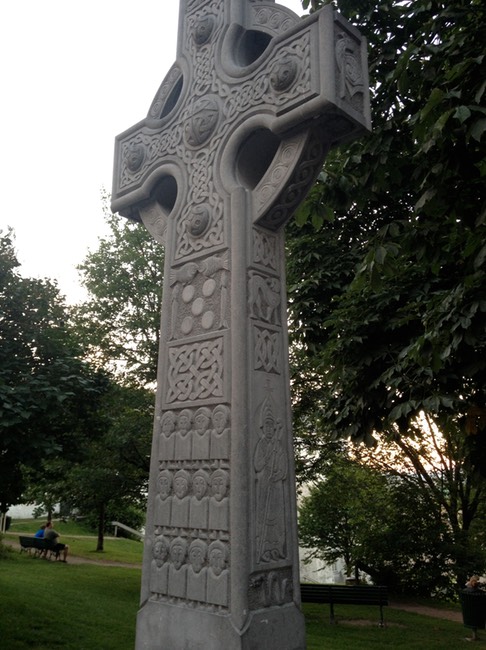
There were pleasant surprises during our stay. We enjoyed the charming Museum of Civilization, with a permanent exhibit on the history of the people of Quebec, and various temporary exhibits on different aspects of culture and civilization. At the Musee des Beaux Arts, we enjoyed art of the Inuit and early Quebecois. Walking along the edges of the old city, we discovered the peaceful Artillery Park, with its unexpected and gorgeous Celtic cross, that we saw looming in the light of sunset. One morning we took a long walk along the waterfront, following a very lovely bike path/pedestrian route through the old port and then along the Boulevard Champlain, where we unexpectedly ended up below the Plains of Abraham at Cap Blanc, where two rows of old houses line the quiet rue Champlain, and there is a park with pool and playground. This old community dates from the nineteenth century, when sailors and shipbuilders populated this picturesque little community.
We spent a divinely perfect five days in this atmospheric and endlessly fascinating Canadian city. It perfectly satisfied our yearning for Europe, while being uniquely itself: not French, but Quebecois.
Photos: Basse Ville; Place d’Youville; rue Saint-Pierre; Hotel Clarendon; rue Saint-Jean; Place Royale; Artillery Park; rue Champlain
La Fleuve Saint-Laurent
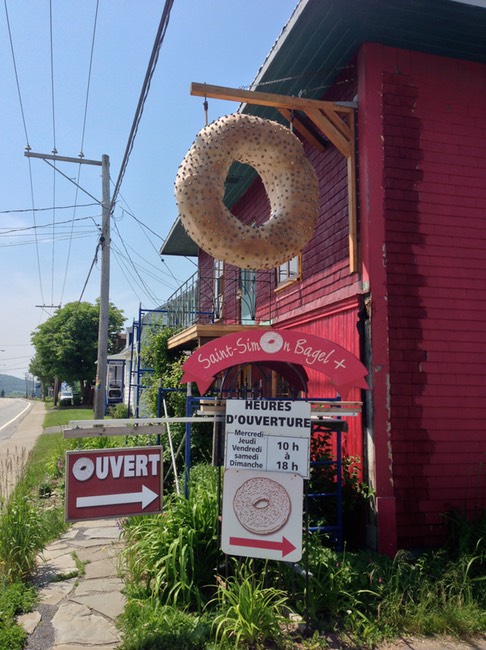
Part two of our three-part Quebec adventure was our exploration of the shores of the Saint Lawrence to the northeast of Quebec City– the road trip part of the vacation. Starting out at Métis, we backtracked upriver, eschewing the highway for the slower Route de la Mer along the shore. Just past the city of Rimouski, a pleasant-looking mid-sized city that would warrant a stay some time in the future, the Route de la Mer rejoined the highway and continued unchanged, a two-lane road passing through the countryside. Passing through the tiny hamlet of Saint-Simon, we spotted a large swinging sign in the shape of a giant bagel. This warranted an immediate stop, where the friendly baker sold us a bag of honey-sweetened Montreal style bagels, made with all natural, local ingredients– heaven with a hole in the middle. Shortly afterward, at the small town of Trois-Pistoles, we found the Fromagerie des Basques, a large-scale operation that clearly had the visitors in mind. We had a brief look in and purchased a smoked maple cheddar for our later enjoyment.
We continued on through farm and ranch land, green and surrounded by low hills, until we reached Rivière-du-Loup, where we took the ferry across the Saint Lawrence. Even here, where the map shows the river much narrower than at Métis, the crossing took an hour. From Saint-Siméon on the opposite side, we had a short drive north through forested hills to the mouth of the Saguenay River, where a small ferry took us across to the town of Tadoussac.

Tadoussac is most famous for its whale-watching industry, which was what had drawn us there, but the bonus is that it is a lovely, charming town with a great deal of history. Founded at the beginning of the 17th century, it was the first French settlement in north America. We visited the excellent history museum on the site of the original settlement, which documented the fur trade origins of the town.
We ate well in Tadoussac, no problem for vegetarians here. We enjoyed beer and pub food the first night, at a place with a nice deck overlooking the bay, and the second night, had a fabulous dinner at Cafe Boheme– amazing pizza, appies, and desserts, all great, with a litre of valpolicella to wash it all down. As we found everywhere in Quebec, there was a good boulangerie that provided us our lunches, and great local beer was readily available as well. We particularly enjoyed a delicious, fizzy blond ale from the Saguenay microbrewerie La Chouape. We also found a cider shop near our hotel, where we purchased some local fruit ciders that were really tasty.
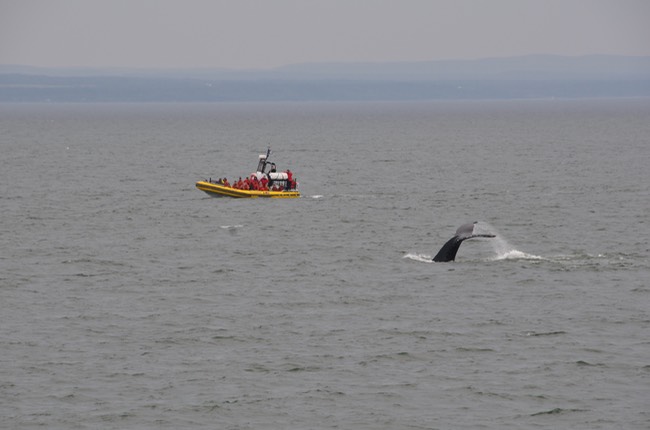
But the main event was the whale watching, and it was spectacular. We saw fin whales, minke whales (one skimming the waves like a dolphin!), a pod of belugas, a seal, penguins and razorbills, and coolest of all, a pair of humpbacks that put on an amazing show. It was fascinating out on the river witnessing the tides and currents interacting, and we had a short cruise into the Saguenay. We later contemplated taking a detour upriver to Lac Saint-Jean, but realized it would just take too long, so we have put further exploration of the Saguenay region on our to-do list for next time.
We carried on with our rambling journey, heading south through the lovely Charlevoix region. It reminded us of British Columbia, with tree-covered rolling hills dotted with farms and ranches. We stopped in La Malbaie, known to the anglos as Murray Bay, and didn’t find much going on, other than a really great artisanal boulangerie, Pains d’exclamation! We bought a perfect baguette and a loaf of walnut bread, and sat down for Lavazza cappuccinos.
Afterward, we continued on to the town of Baie Saint-Paul, where we visited the wonderful fromagerie Migneron up on the hill. There were beautiful views down over the fields where the sheep were grazing, and down into the cheesemaking room where they were wiping the big wheels! Cheesemaking is big in the area as the Charlevoix is a dairy region; there is a cheese museum in Baie Saint-Paul that we didn’t have the time to visit, but that looked fascinating. Another time!
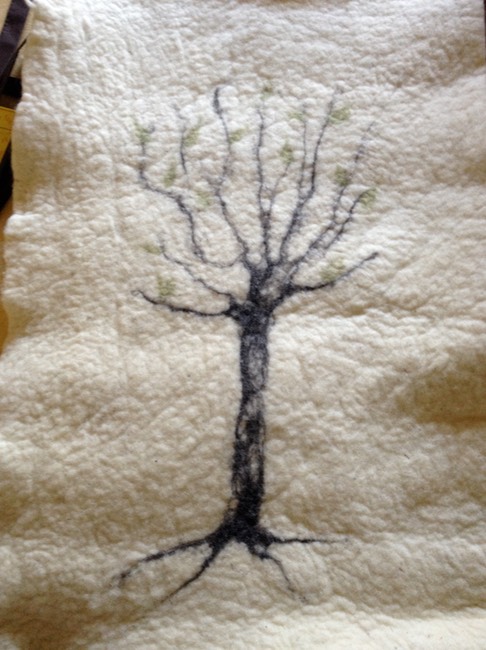
Baie Saint-Paul is a charming art-centred town, with a quaint centre-ville featuring lots of galleries, shops, and restaurants. While we were there, the main street had been dug up and the sidewalks were being renovated, so it was unfortunately quite a mess, but nice despite that. The downtown will be lovely when finished, as there are beautiful historic buildings everywhere, and there is a friendly, uncrowded feeling about the place. The art galleries were varied and fascinating, featuring lots of different styles and quite high quality. Our fourteen-year-old son enjoys contemporary art a great deal, and we were impressed with the respect and friendliness with which he was treated by the proprietors. Despite the fact that they were clearly not going to make any big dollar sales, they were happy to discuss the artists and the work with him, and answer his questions. We visited a wool shop which is trying to bring back the weaving industry to the region; we bought a tapestry woven from the Charlevoix wool.
We also visited the contemporary art museum, as well as the town’s lovely Church of Saint Peter and Saint Paul, which features an organ by the renowned Quebec organ builder Casavant. Later we drove along the river to the little community of Les Eboulements, where there were a number of shops selling folk art and paintings, and we visited an excellent chocolate shop. There were beautiful views of the river and Baie Saint-Paul.
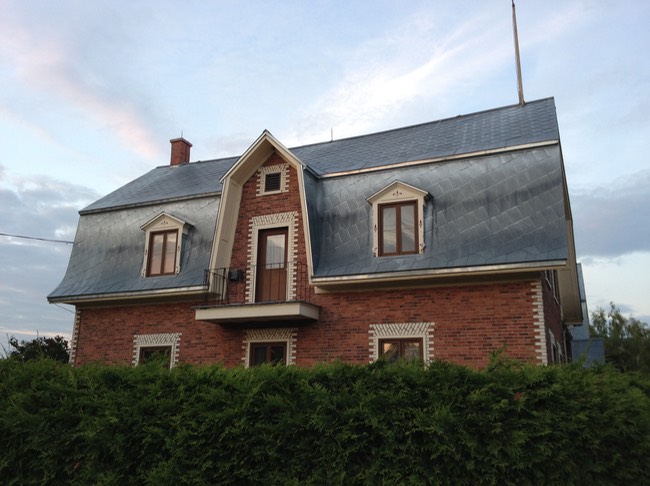
Once again, we ate well during our two-day stay, enjoying local cheese and beer for lunch, and two lovely dinners. The first was in the charming Cafe des Artistes, where we had excellent thin-crust pizza, including one called “La grande bleue”. The second was at Chez Pineault, an Italian restaurant across from the church. There was lots of goat cheese here– on the spinach/chevre ravioli, and loads of it on the pizza quatre fromages. There were generous tasty salads with everything, really good frites, and a Quebecois treat called “fondue parmesan”, small squares of cheese rolled in bread crumbs and deep fried. Delicieux!
Overall, we discovered a region filled with the French and the not-French Amazing French-style cheeses are made here, but rather than wine, craft beer rules. As in France, towns and cities of all sizes feature large churches at their heart, they are eclectic in design, and commonly feature the tin-covered spires typical of Quebec. Rather than closely-built European-style towns and villages, the communities feel distinctly North American in their spaciousness. It is a delightful region of old and new, farms and towns, land and sea.
Photos: cheese curds in the Fromagerie des Basques; bagel stop in Saint-Simon; historic Tadoussac church; humpback whale; Saguenay River; Charlevoix tapestry; traditional building in Baie Saint-Paul
Métis-sur-Mer
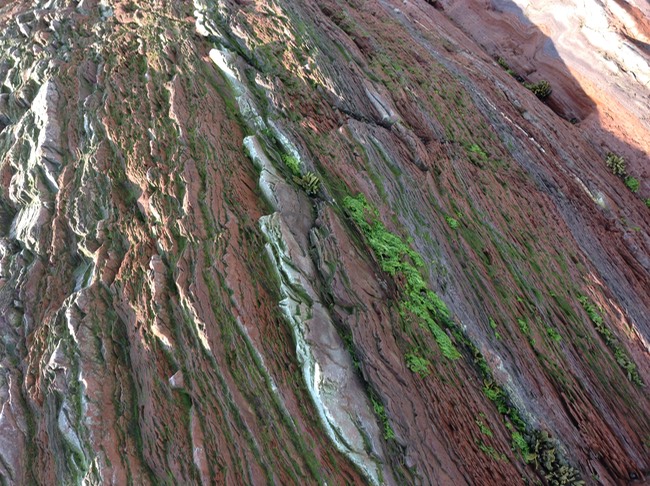
Métis-sur-Mer, Quebec, sits at the beginnings of the Gaspé Peninsula on the bank of the Saint Lawrence, where the river has essentially become the sea. This tiny summer community founded by Scots is an Anglo enclave in a sea of francophonie, and as we discovered after arrival, is universally called something that sounds more like a French painter than an aboriginal people. The community has a long history of cottagers from Montreal and other nearby areas, while the local francophones live here year round in the enclave of Les Boules. Most of the families have a long background in the community, and everyone knows one another.
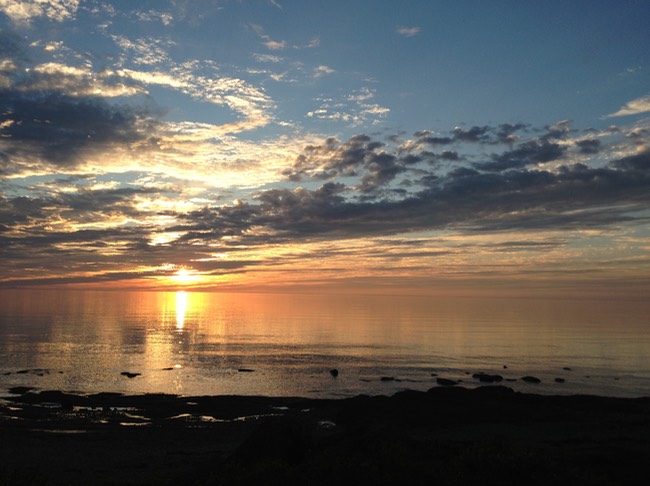
The river is at least 50 kilometres across at this point; you cannot see the other side. It looks, feels, and smells like the sea. The beach is rocky, with long expanses of smooth red stone interspersed with sandy, pebbled patches. When the wind is blowing hard, there is the constant roar of the waves washing over the rocks. We walked daily along the beach, while the young sons of our hosts played gleefully in the tidal pools; one day, we watched as a minke whale made its way along the shoreline. Some nights, we saw sunset light up the sky with streaks of red and purple, and others, we watched the fiery, deep red ball of the sun sinking below the horizon, leaving very little residue behind. Each night, our son built up a huge bonfire for us to enjoy. There was magic in the crackling wood, the colours deep within the flames, and the sparks flying upward into the deep starry night.
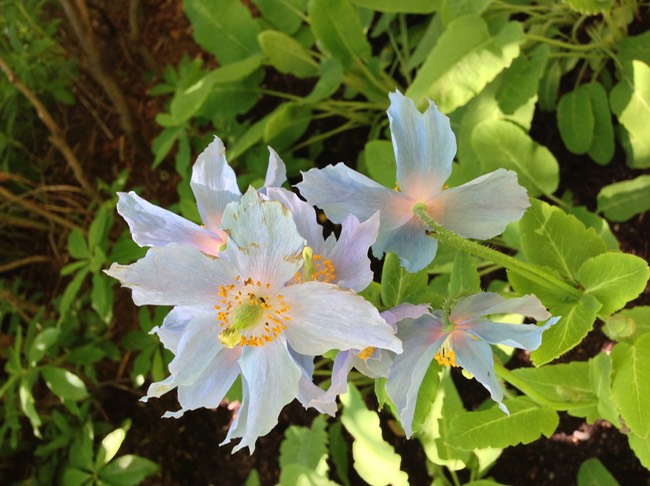
Away from the water, we visited the world-famous Jardins de Métis, a beautiful public landscape garden that hosts an annual festival featuring the conceptual gardens of designers from around the world. Both the designs of this year’s festival, and the permanent gardens themselves, were fascinating. We were fortunate to be there at the right time of year to see the famous blue poppies in bloom. These flowers with origins in the Himalayas find themselves right at home in the climate of the Gaspé, where humid days and cool nights are perfect for them.

Further along the peninsula, at the community of Baie-des-Sables, we found a roadside fromagerie run by a friendly and cheerful francophone woman. They had a number of nice country-style cheeses for sale, and of course, curds. Quebec cheddar is excellent, and fresh curds are a key ingredient in the quintessential Quebecois snack, poutine. Crisp hot fries, topped with a mound of squeaky fresh curds and warm gravy– heaven on a platter! We made ours with vegetarian gravy.
On the Matane road, we passed a ranch with a house built like a little castle, as though the rancher were Mad King Ludwig of Bavaria. But most of the houses around here are either large, Cape-cod style houses, or Quebecois cottages with the typical peaked, slanting roofs. One house in the village is built in 15th-century half-timbered style (not quite as out of place as the castle, but still a little odd in its surroundings).
One evening, the men of our party decided that it was necessary to swim in the river. They went out, doused themselves thoroughly in the frigid water, then returned for warming beverages of various kinds. The next morning, our host reported, he was greeted at the golf course with, “I hear you were in the river.” Metis is that kind of a community: intimate, personal, quirky. And perched quietly in a part of the country that is achingly, breathtakingly beautiful.
Photos: Métis shoreline; rock stratification on the beach; two sunsets; two sunsets; blue poppy; quintessential Quebecois houses; sunset
